
As readers of ByDanJohnson.com know, we enjoy keeping a tight (though not exclusive) focus on the aircraft we love to fly. That approach is not changing but I discovered two products at DeLand Showcase 2019 that can make airplanes safer, perhaps much safer.
As the show concludes tomorrow, I will resume focus on aircraft with more news and fresh video. For now, please consider these two products.
Teknofibra’s Miraculous Cloth
I recorded video with developer and company founder Alessandro Molteni watching as his U.S. representative Mark Harper did a demonstration like you see in the nearby photos.
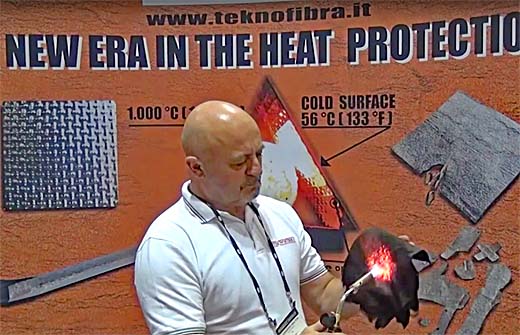
It looked for all the world like a visual trick — the way a magician or sleight-of-hand artist might fool you. Yet I stood right nearby watching a live person hold a blue-flame torch up to the palm of his hand, protected only by a soft cloth of 4 millimeters (about 1/6th of an inch or about a stack of 3 dime coins). That was the only barrier between tender human skin and a hot fire of more than 2,000°F.
Mark admitted to being nervous before doing this demonstration the first time but he seemed no worse for the wear after applying the scorching torch to the cloth on his hand for more than 30 seconds.
To say I was impressed would be gross understatement.
Working with Teknofibra
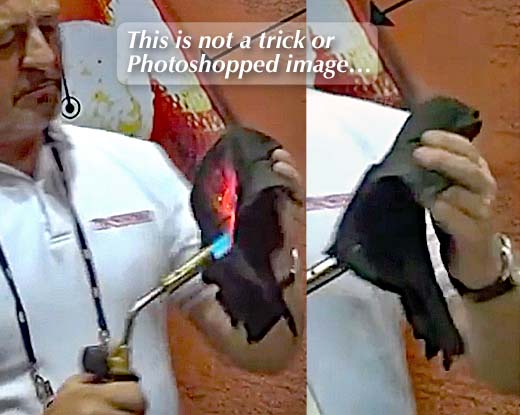
The magical material is made of carbon fiber (about 80%) and the balance a closely-guarded secret. Soft to the touch, something like felt, Teknofibra cuts easily with a scissors and does not produce fibers that are harmful.
Ceramic fibers may have similar heat resistance but working with such material requires a breathing filter, gloves, and other protective clothing. If you’ve ever rubbed again fiberglass insulation with bare skin, you know how uncomfortable that is and it can itch for days. Ceramic fiber is said to be much worse. Teknofibra seems innocent in comparison.
Taking the material directly from Mark after his blowtorch demo, the cloth felt only slightly warm. It appeared completely unaffected and is comfortable enough against the skin that you could make fire retardant clothing from it, I imagine.
Uses of Teknofibra
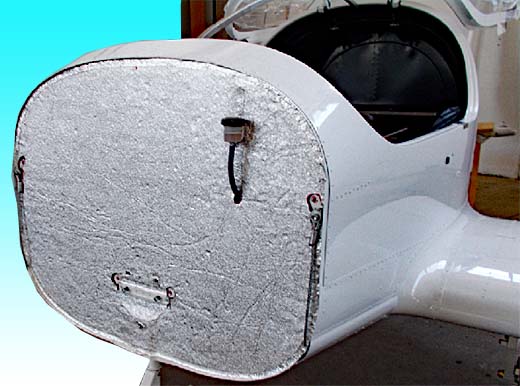
Mark Harper is not an aviation guy. His business supplies high-end motorcycle racing. One use is to protect fiberglass body parts from hot exhaust pipes near the bodywork. Alessandro said it is widely used in auto racing and customers include a wide range of top names in that field. The uses are potentially endless.
For pilots… the uses are arguably even more valuable because of the seriousness of an in-flight fire. A firewall protected with material about 8 mm thick (a little more than a quarter inch) can be mated to a thin foil on one side and with an adhesive on the other. Recall it can easily be cut to fit precisely.
In addition electrical wires and fuel lines can be wrapped with material. Teknofibra supplies this in pre-made tubes of many dimensions. For an airplane manufacturer or kit builder, this would be a great finish. Airplanes already flying can use a sheet form of the material with strategically-placed adhesive so you can wrap the wires or fuel lines.
Still Not All the Value
Fire resistance is certainly a worthy application of Teknofibra but it also has very significant sound deadening capabilities. A test stand involving an 8-inch wide tube into which was inserted a sheet of the 8 millimeter (or so) material such that it filled the inside diameter of the tube. At the bottom was an electric bell.
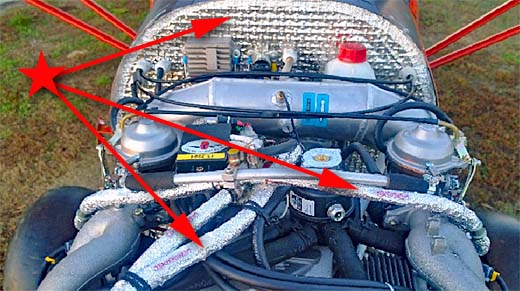
When the Teknofibra was in the tube I could hear the bell ringing but it was clearly muted. When Mark pulled out the Teknofibra inner cylinder, the bell was at least twice as loud, maybe more.
Imagine not only the firewall but your cockpit side panels, floor, and ceiling being lined with Teknofibra before the interior finish was applied. You might quiet your cockpit fairly dramatically and that can reduce pilot fatigue.
Technically-inquisitive readers can go to Teknofibra’s page, which explains how the material works.
Ah, but such a remarkable material must be very expensive, yes? Nope. A firewall for a common Light-Sport Aircraft might cost around $100-150. Surrounding the entire cockpit with the miracle fiber might run $1,000 but you’d have one of the quietest (and safest) cockpits anywhere. Compared to the cost of many LSA today, that seems a modestly-priced and worthy option. Contact Mark at his website to learn more.
Anti-Explosion Fuel Tank
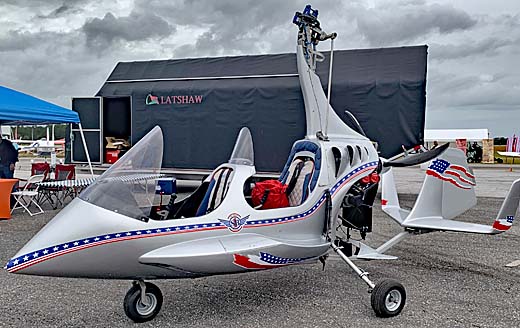
I did not get to examine this in the same way as Teknofibra, but the Skyblazer 1 gyroplane from Italy has a special fuel tank under the aft seat. This seems another worthy development to consider. The idea is not new but imagine experiencing an aircraft accident where no fuel can be spilled. Fire danger drops sharply.
These cost more than standard fuel tanks, but I was told by a reliable source that a completely filled anti-explosive tank — sometimes called a “safety tank” — can sustain a drop from 100 feet without rupturing. Several light aircraft makers use such tanks to increase safety.
Put anti-explosive tanks and Teknofibra together and you significantly increase fire safety for airplane occupants. Doesn’t that seem worth further consideration?


With this in mind I adapted a race car product called Cold Fire. This product uses a hard plastic tubing that will breach @ ~ 210 degrees or when exposed directly to flames and releases the Cold Fire liquid under pressure to the effected area of exposure and snuff’s out the flames. Here is a video link to the product being used. https://youtu.be/zgdqaoNXIhE
While this unit is for use in racing vehicles I have made my own version adapted for my gyro since I use a seat tank. This can be seen here: https://www.facebook.com/RX1.Wolverine
Thank You for your coverage of gyroplanes. I am always looking forward to new coverage and articles about my favorite way to fly!